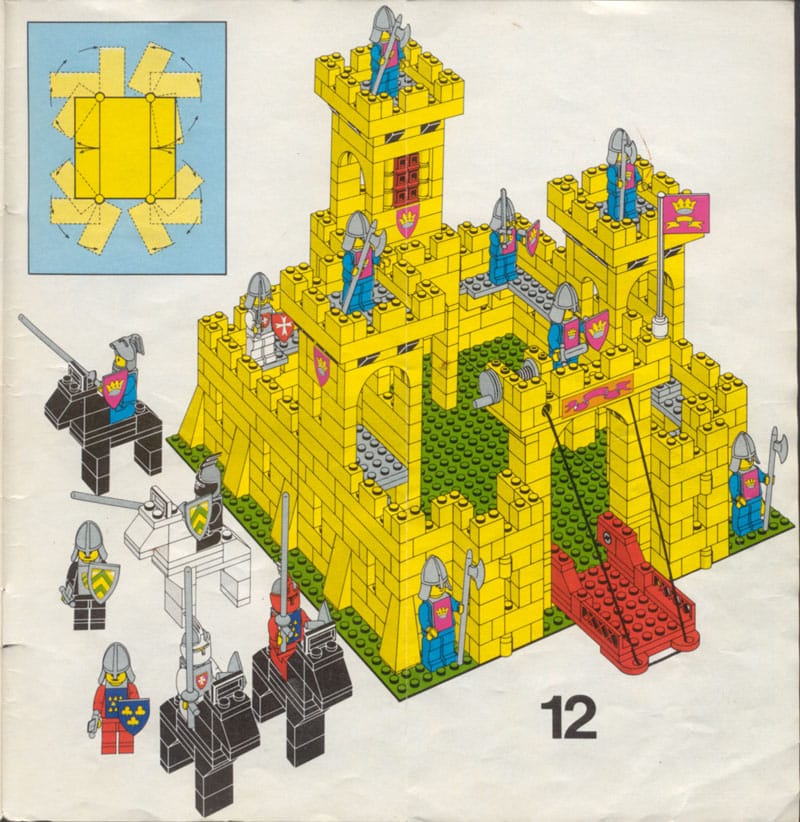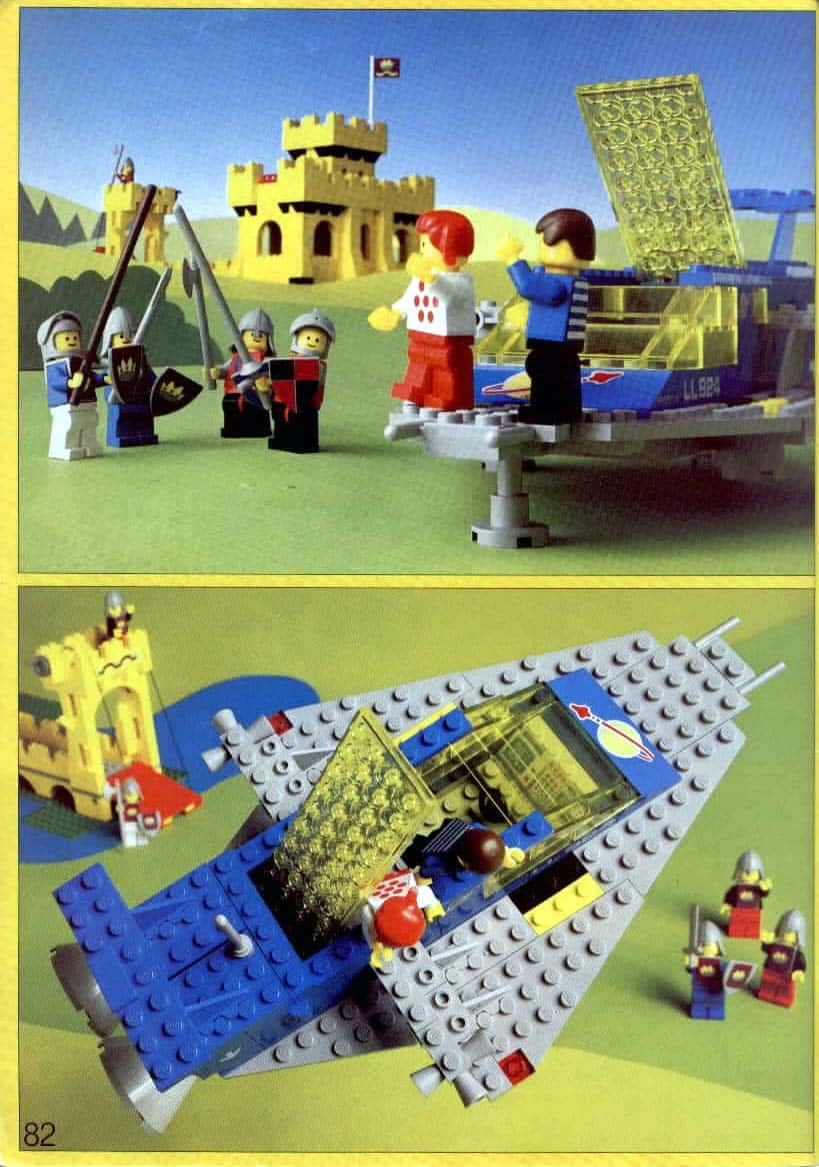I grew up in a world without LEGO minifigures. I received my first set of LEGO bricks as a Christmas gift in 1973—a wide, white box full of flat, green “grass” pieces, primary-colored bricks, and potential. I constructed houses with doors and windows that opened and closed. I built cars, both the ones illustrated on the box and monstrous contraptions not unlike modern Humvees. And when I needed people, I made them. So did every other kid I knew. Two or three one-by-one LEGO bricks stacked one atop the other—yellow head, red torso, and blue legs—were all I needed to populate my LEGO world. I may have been dimly aware of the introduction of the vaguely person-shaped LEGOLAND figures in 1974, but they didn’t make much of an impact on my life. More recently, however, my son inspired me to learn all about minifigs.
 I can now tell you that the modern minifig debuted as a key element of three new LEGO themes in 1978: town, castle, and space. Initially the 1.5-inch figures had the familiar yellow barrel head, rhomboid body, moveable arms, and blocky legs. Dressed and accessorized for their roles, minifigs proved instantly popular. That year, more than half the sets introduced by LEGO included them, and several sets—particularly in the LEGO Town—contained a minifig and a vehicle (albeit one that was too small for the minifig to ride in; more spacious vehicles followed in late 1978 and early 1979).
I can now tell you that the modern minifig debuted as a key element of three new LEGO themes in 1978: town, castle, and space. Initially the 1.5-inch figures had the familiar yellow barrel head, rhomboid body, moveable arms, and blocky legs. Dressed and accessorized for their roles, minifigs proved instantly popular. That year, more than half the sets introduced by LEGO included them, and several sets—particularly in the LEGO Town—contained a minifig and a vehicle (albeit one that was too small for the minifig to ride in; more spacious vehicles followed in late 1978 and early 1979).
 A policeman in a set with a police car was the first modern minifig, but it took a knight to launch minifigs to the prominence they enjoy today. Fourteen castle knights came with the 1978 castle set, three times more than any other set produced that year or the next. The knights wore removable helmets and wielded an assortment of swords, halberds, and lances in their C-shaped hands. These extensively accessorized minifigs proved so popular that LEGO marketed them separately, offering them both as a stand-alone set and as a polybagged “service pack” intended to supplement existing sets.
A policeman in a set with a police car was the first modern minifig, but it took a knight to launch minifigs to the prominence they enjoy today. Fourteen castle knights came with the 1978 castle set, three times more than any other set produced that year or the next. The knights wore removable helmets and wielded an assortment of swords, halberds, and lances in their C-shaped hands. These extensively accessorized minifigs proved so popular that LEGO marketed them separately, offering them both as a stand-alone set and as a polybagged “service pack” intended to supplement existing sets.
 Until the introduction of the LEGO pirate theme in 1989, the castle line ranked among the most popular, growing to include nine distinct LEGO sets, four of which contained nothing but minifigs: knights (quickly split into crusaders and Black Falcon factions), woodmen, and peasants, all adapted to wield a vacuum-clogging array of tiny shields, spears, crossbows, bows and arrows, spears, cups, and pitchforks. The knights even had horses to ride on, their LEGO-block feet sliding into a deep notch on the steed’s back.
Until the introduction of the LEGO pirate theme in 1989, the castle line ranked among the most popular, growing to include nine distinct LEGO sets, four of which contained nothing but minifigs: knights (quickly split into crusaders and Black Falcon factions), woodmen, and peasants, all adapted to wield a vacuum-clogging array of tiny shields, spears, crossbows, bows and arrows, spears, cups, and pitchforks. The knights even had horses to ride on, their LEGO-block feet sliding into a deep notch on the steed’s back.
 It’s difficult for me to escape the conclusion that we lost some imaginative element when people with faces, clothes, and tiny accoutrements entered the LEGO world. Last year, my seven-year-old son received a LEGO Brickmaster set from a friend. The hybrid box/book proclaimed that the set included more than 140 bricks and two minifigures! Inside, he found a small bag of LEGO bricks, the parts for both a soldier and a pirate (complete with a LEGO peg leg), and a jumble of LEGO-sized accessories: a treasure map, several cutlasses, a couple blunderbusses and pistols, a treasure chest full of LEGO gems, and everything necessary to build a cannon capable of launching LEGO cannonballs into the inaccessible spaces behind our couch and bookshelves.
It’s difficult for me to escape the conclusion that we lost some imaginative element when people with faces, clothes, and tiny accoutrements entered the LEGO world. Last year, my seven-year-old son received a LEGO Brickmaster set from a friend. The hybrid box/book proclaimed that the set included more than 140 bricks and two minifigures! Inside, he found a small bag of LEGO bricks, the parts for both a soldier and a pirate (complete with a LEGO peg leg), and a jumble of LEGO-sized accessories: a treasure map, several cutlasses, a couple blunderbusses and pistols, a treasure chest full of LEGO gems, and everything necessary to build a cannon capable of launching LEGO cannonballs into the inaccessible spaces behind our couch and bookshelves.
 My son and I spent several tiring hours working our way through the instruction booklet, building caves and castle gates, caissons and cannons. We pitted pirate against soldier in pitched and short-lived skirmishes (“Now create your own pirate adventure!” the book commanded) before moving on to the next model. Within a week, though, I discovered to my delight that the bricks had been absorbed into our general mass of LEGOs and the pirate and solider had joined the ranks of our two LEGO armies (pirates-Sith-Stormtroopers versus soldiers-Jedi-Clone minifigs). The instructions haven’t been off the shelf since, and the last time I saw the pirate he held a laser blaster, had a tiny tentacle for one hand, and wore a motorcycle helmet. Then I saw my son stacking up black and green bricks to build his own Frankenstein. Despite the rise of LEGO kits and minifigs, in my house, at least, imagination is alive and well.
My son and I spent several tiring hours working our way through the instruction booklet, building caves and castle gates, caissons and cannons. We pitted pirate against soldier in pitched and short-lived skirmishes (“Now create your own pirate adventure!” the book commanded) before moving on to the next model. Within a week, though, I discovered to my delight that the bricks had been absorbed into our general mass of LEGOs and the pirate and solider had joined the ranks of our two LEGO armies (pirates-Sith-Stormtroopers versus soldiers-Jedi-Clone minifigs). The instructions haven’t been off the shelf since, and the last time I saw the pirate he held a laser blaster, had a tiny tentacle for one hand, and wore a motorcycle helmet. Then I saw my son stacking up black and green bricks to build his own Frankenstein. Despite the rise of LEGO kits and minifigs, in my house, at least, imagination is alive and well.



